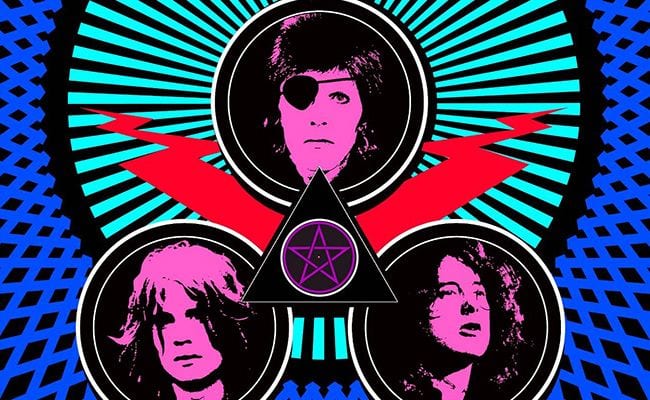
One of the pivotal moments of my young life was carrying around a plastic margarine tub filled with cassettes in a desperate attempt to impress a teenage girl. I was seven, and I knew this accumulation of magnetic tape was just the thing to attract her. After days of fantasizing about lip synching to Bon Jovi’s “Never Say Goodbye” while she and her friends watched in awe, I decided to make my move. I showed her the tapes, an assortment of ’80s hair metal bands whose music was as processed as the yellow goop which once filled the container, and she said the unimaginable: “That’s devil music.”
I only knew a little about the devil. My mother, who sent me to church but never attended herself, told me not to sing Def Leppard’s “Armageddon It” because it was about “the end of days”, but that was as far as the hand of God reached into my life. Still, I knew enough of heaven to know my favorite music was hardly the work of Satan. It was insipid, not insidious. It was years before I realized that the best music always flirts with magic and darkness.
Peter Bebergal’s Season of the Witch: How the Occult Saved Rock and Roll shows how Satan, the Elder gods, and other mysterious forces cast a spell over rock ‘n’ roll — and made it better. This subject has been covered by concerned parents and long-haired hermeneutics enthusiasts since the dawn of rock ‘n’ roll, but Bebergal is uniquely suited to the task. He’s written about drugs and faith in his own life, and he’s profiled dark wizards like Samuel R. Delany, Thomas Ligotti, and Michael Moorcock for The New Yorker. This book resides at the intersection of these subjects, a crossroads where mysticism, Eastern religions, psychedelics, and charismatic practitioners of every type of hoodoo imaginable meet.
Originally released in hardcover in 2014, this book goes beyond the cartoonish images of Alice Cooper’s stage show, and Ozzy Osbourne biting the head off a bat, to find the magical sources at the root of both rock ‘n’ roll’s greatest performers and its unsung heroes. From David Bowie burning black candles, to Arthur Brown becoming the god of hellfire, and Coil’s sex magic sigils, Bebergal covers a lot of ground.
The forces at work on the musicians and their music are not always dark, however. For Bebergal, anything going against the Christian orthodoxy of the Western world fits the bill, starting with rock’s sex and drugs connection to the myth of Dionysus and moving up toward the West African trickster god Eshu’s transformation into the devil at Robert Johnson’s crossroads.
The ’60s figure heavily in Bebergal’s book, of course, as that decade was defined both by its resistance to orthodoxy in all its forms and the waves of seekers leading the charge. The Beatles’ quest for enlightenment is legendary, but dabbling in transcendental meditation was just a fraction of their occult impact, Bebergal writes. The “Paul is dead” hoax, while not directly related to any occult practice itself, was indicative of many fans’ search for hidden, deeper meanings in the band’s work. It also added fuel to the fire of fundamentalists who found Satanic messages hidden in the band’s album covers in the wake of John Lennon’s “bigger than Jesus” remark.
Despite the brevity of their foray into the occult, the Beatles typify the how and why of rock bands that often turn spiritual. Bebergal writes, “The privilege that comes with status is part of why rock and the occult became wedded so quickly.” Rock stars replaced all the idols of old, and their fame afforded them the luxury to indulge in spiritual pursuits.
Bebergal writes about the “satanic panic” which rose alongside rock ‘n’ roll, a parallel universe of paranoia and biblical absurdity, but never lets it take over the spotlight. His writing is insightful, engaging, and serious, but there’s a hint of comedy hanging over the entire book. His subject covers magics both black and white, the power of sigils, and the shamanistic attributes of rock concerts, all subjects easily researched in books bound by normal means rather than through sacrificing the flesh of virgins.
Despite the ease of access to this information, there has long been a thread of fundamentalist thought which has operated as if this information is hidden, like some sort of dark rites must be performed to learn about Jimmy Page’s interest in Aleister Crowley. Had this book appeared 30 years ago, the volume of the collective gasp of the members of the Parents Music Resource Center (PMRC) would have rivaled any band of the day. Now, it’s as funny as it is interesting.
Season of the Witch isn’t some alternative history of rock ‘n’ roll, it’s the history. Church leaders and concerned parents have been right all along — rock ‘n’ roll is of the devil. Thank god.


![Call for Papers: All Things Reconsidered [MUSIC] May-August 2024](https://www.popmatters.com/wp-content/uploads/2024/04/all-things-reconsidered-call-music-may-2024-720x380.jpg)



